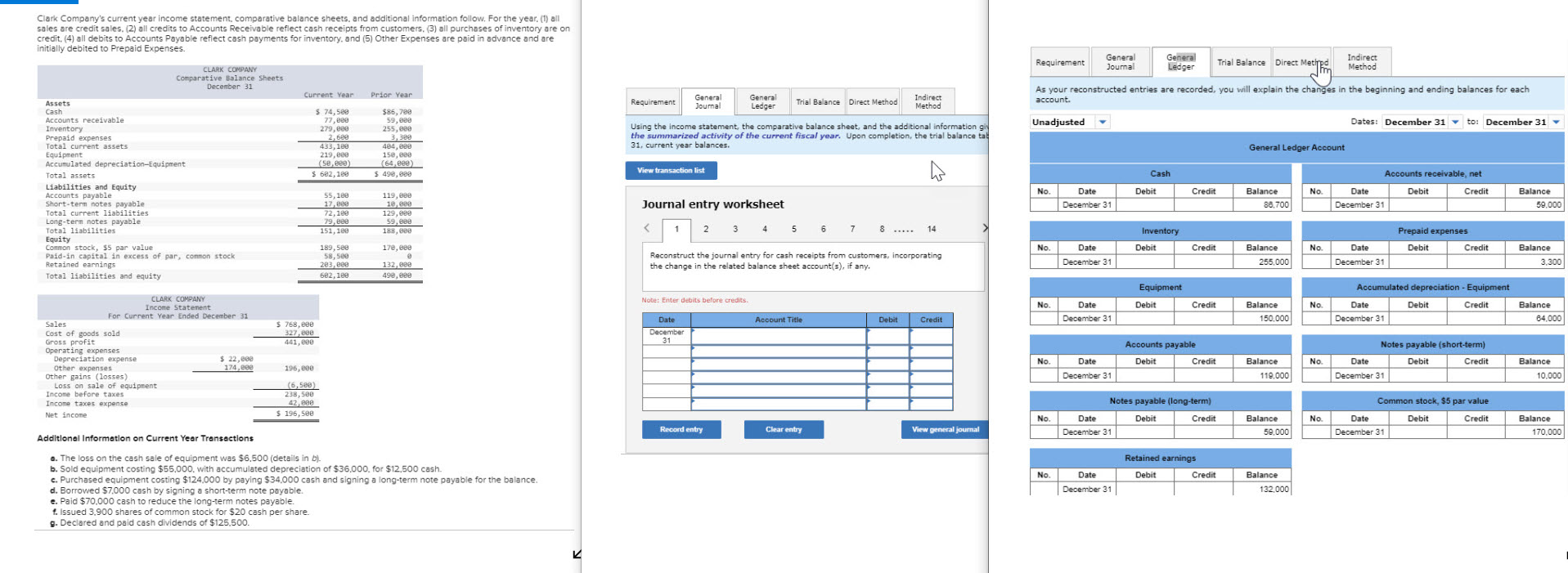Answered step by step
Verified Expert Solution
Question
1 Approved Answer
Clark Company's current year income statement, comparative balance sheets, and additional information follow. For the year. (1) all sales are credit sales, (2) all

Clark Company's current year income statement, comparative balance sheets, and additional information follow. For the year. (1) all sales are credit sales, (2) all credits to Accounts Receivable reflect cash receipts from customers, (3) all purchases of inventory are on credit. (4) all debits to Accounts Payable reflect cash payments for inventory, and (5) Other Expenses are paid in advance and are initially debited to Prepaid Expenses. Assets Cash Accounts receivable Inventory Prepaid expenses Total current assets Equipment Accumulated depreciation-Equipment Total assets Liabilities and Equity Accounts payable Short-term notes payable Total current liabilities Long-term notes payable Total liabilities Equity CLARK COMPANY Comparative Balance Sheets December 31 Current Year Prior Year $ 74,500 77,000 $86,700 59,000 279,000 255,000 2,600 3,380 433,100 404,000 219,000 $ 602,100 55,100 17,000 (50,000) 150,000 (64,000) $ 490,000 119,000 10,000 72,100 129,000 79,000 59,000 151,100 188,000 Common stock, $5 par value 189,500 170,000 Paid-in capital in excess of par, common stock 58,500 Retained earnings 203,000 132,000 Total liabilities and equity 602,100 490,000 CLARK COMPANY Income Statement For Current Year Ended December 31 Sales $ 768,000 Cost of goods sold 327,800 Gross profit 441,000 Operating expenses Depreciation expense Other expenses Other gains (losses) Loss on sale of equipment Income before taxes Income taxes expense Net income $ 22,000 174,000 196,000 (6,500) 238,500 42,000 $196,500 Additional Information on Current Year Transactions a. The loss on the cash sale of equipment was $6,500 (details in b). b. Sold equipment costing $55,000, with accumulated depreciation of $36,000, for $12,500 cash. c. Purchased equipment costing $124,000 by paying $34,000 cash and signing a long-term note payable for the balance. d. Borrowed $7,000 cash by signing a short-term note payable. e. Paid $70,000 cash to reduce the long-term notes payable. f. Issued 3.900 shares of common stock for $20 cash per share. g. Declared and paid cash dividends of $125,500. Requirement General Journal General Ledger Trial Balance Direct Method Indirect Method Using the income statement, the comparative balance sheet, and the additional information giv the summarized activity of the current fiscal year. Upon completion, the trial balance tal 31, current year balances. View transaction list General Requirement Journal General Ledger Trial Balance Direct Metired Indirect Method As your reconstructed entries are recorded, you will explain the changes in the beginning and ending balances for each account. Unadjusted Dates: December 31 to: December 31 General Ledger Account Cash Accounts receivable, net No. Journal entry worksheet 234567 Reconstruct the journal entry for cash receipts from customers, incorporating the change in the related balance sheet account(s), if any. Date December 31 Debit Credit Balance No. 88,700 Date December 31 Debit Credit Balance 59,000 8. 14 Inventory No. Date December 31 Debit Credit Balance 255,000 No. Date December 31 Prepaid expenses Debit Credit Balance 3,300 Equipment Note: Enter debits before credits. No. Date December 31 Account Title Debit Credit Date December 31 Debit Credit Balance 150,000 No. Date December 31 Debit Accumulated depreciation - Equipment Credit Balance 64,000 No. Date Accounts payable Debit Credit December 31 Balance 119,000 No. Date Notes payable (short-term) Debit Credit Balance December 31 10,000 No. Record entry Clear entry View general journal Date December 31 Notes payable (long-term) Debit Credit Balance 59.000 No. Date December 31 Common stock, $5 par value Debit Credit Balance 170,000 No. Date December 31 Retained earnings Debit Credit Balance 132,000
Step by Step Solution
There are 3 Steps involved in it
Step: 1
Based on the information provided we can prepare the journal entries for the transactions of ...
Get Instant Access to Expert-Tailored Solutions
See step-by-step solutions with expert insights and AI powered tools for academic success
Step: 2

Step: 3

Ace Your Homework with AI
Get the answers you need in no time with our AI-driven, step-by-step assistance
Get Started


